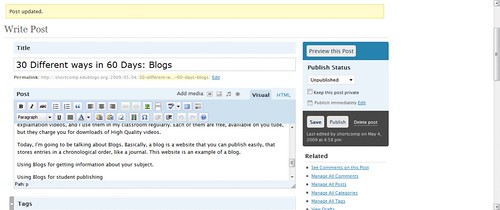Animation in the Classroom
I teach animation to Years 7-12 in Technology, then IST and Ind Tech. We use Flash, which students even at a younger (secondary) age have had some good success in. However, we can afford the luxury of time to teach the technology in technology subjects, as it’s the basis of the course. Today, I thought I’d cover some animation tools that allow you to use animation in the classroom without having to teach the technology.
I’ve written about this before, so I’ll steal some info from a previous post:
Have been checking out GoAnimate for the last hour.Since I have a fair amount of knowledge in Flash, I approached GoAnimate quite skeptically. After about 10 minutes fiddling around with their very simple interface, I think that it may be a great animation tool for those that know absolutely nothing (and don’t need to) about the technical skill of animation. I’m definately planning on implementing this into my Year 7 Technology (Mandatory) class, but also see it as a very simple tool for effective implementation of ICT into any curriculum. You can use a variety of their characters, and backgrounds, and create simple storyboards, with even complex emotions shown in animations.
Movie Maker/Imovie: you can get students to draw individual frames and import them into movie maker or imovie and add transitions and effects. I’ve found that some of the other free tools are easier than this, but if you’re operating on limited bandwidth, these tools are not effected by this.
Pivot: Also a good program. Free, and not internet based, so no bandwidth issues. You create stick figures and then animate them based on the pivot points of the animation. You are, as far as I’m aware, limited to stick figures, however, but you can put in stick figures of things like horses.
Stop Motion animations can be created quickly and easily using Monkey Jam. Money Jam is a free program available on the net, but that doesn’t use the internet at all for running. You can created a simple play-do animation, but you could use anything, from kids toys to Lego to show simple narratives, or build moving models of concepts. This is really the easiest, most motivating way to do it, with no technical knowledge or bandwidth required.
I’ve included instructions for how to use Monkey Jam (at the bottom of this screen, that I used at a PEEL meeting. Please feel free to photocopy and use the instruction page in class if necessary. (We also had some serious fun playing with the play-do.)
Pencil Animation is a program that will allow you to download hand drawings and to run them together into an animation. Good for testing animations for technology, but you can create a flick-book style animation easily with this.
Some ways to use this in the classroom involve:
- Digital Storytelling: English, HSIE, technology, Science, really any subject that involves any kind of narrative.
- Idea Communciation: A tool for presenting an idea that may (hopefully) stimulate conversation by students. Eg, “create a video presenting safety issues in the workshop”
- Responding to ideas: You could create a video log, responding to each others animations.
- Awareness Programs: Students could create awareness programs for relevant issues, such as health issues for PDHPE, Environment in Science, TAS, HSIE
- Interpretation of texts: Converting different texts in English to an animation. This could also be used for fairly fact based texts by presenting them in an unusual way.e: Creation of animation helps in the understanding of setting the scene.
- Drama: creative interpretation
Advantages:
- Students can collaborate on ideas.
- Great for literacy skills
- Students plan out their animation before creating. Allows for development of storytelling/narrative skills.
- It’s very motivating. Students get really excited about it.
- You avoid the inevitable “But I can’t draw!” Comments
- Good for kinesthetic students that need to move things around to understand concepts
